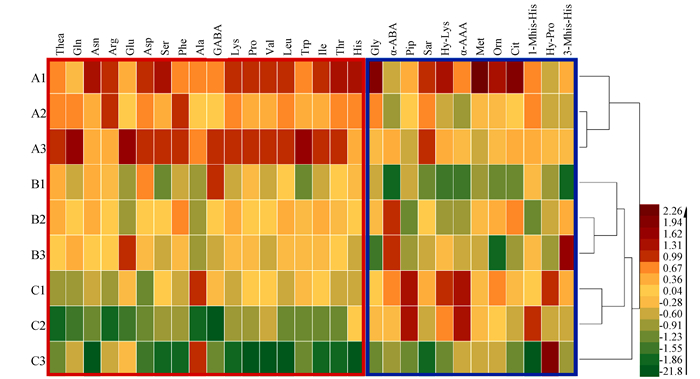Amino Acids in White Peony Teas of Different Grades
-
摘要:
目的 通过对不同等级白牡丹茶游离氨基酸的分析,探究氨基酸种类与白牡丹茶品质等级的关系。 方法 采用AQC柱前衍生结合超高效液相色谱-串联质谱法(UHPLC-MS/MS)测定游离氨基酸后,通过结合偏最小二乘法判别分析法(Partial least squares discrimination analysis,PLS-DA)和聚类分析法,对9批次不同等级白牡丹茶的35种游离氨基酸进行分析。 结果 白牡丹茶中除β-氨基丁酸、同型半胱氨酸、半胱氨酸、胱氨酸、酪氨酸5种氨基酸外,其余30种氨基酸均高于定量限。相关分析结果显示,游离氨基酸与白牡丹品质等级间存在密切相关性;其中,γ-氨基丁酸、丝氨酸、脯氨酸、色氨酸、甘氨酸对于白牡丹茶滋味品质的影响最大;味觉分析结果显示,γ-氨基丁酸对白牡丹茶滋味的收敛性有重要贡献,而其余氨基酸主要通过交互作用对白牡丹茶滋味品质产生贡献。 结论 白牡丹茶的游离氨基酸构成与其品质等级间存在密切相关性,不同氨基酸组分通过交互作用对白牡丹茶的滋味等级形成产生整体性的贡献作用。 Abstract:Objective The amino acids in white peony teas of various quality grades were compared. Method Free amino acid compositions of 9 white peony tea specimens were determined using AQC pre-column derivatization combined with the ultra-performance liquid chromatography-tandem mass spectrometry (UHPLC-MS/MS). The analytical results on 35 amino acids were compared for the study by the partial least squares discrimination analysis (PLS-DA) and cluster analysis. Result Aside from β-aminobutyric acid, homocysteine, cysteine, cystine, and tyrosine, the remaining 30 amino acids in the tea samples showed higher contents than the limit of quantitation. The correlation analysis on the data indicated a significant correlation between the amino acid composition and the quality of the teas. For instance, γ-aminobutyric acid, serine, proline, tryptophan, and glycine significantly affected the taste, while γ-aminobutyric acid was crucial on the astringency, of the brewed tea as shown in a taste test. The other amino acids appeared to interactively contribute to the sensory quality. Conclusion Either individually or interactively, free amino acids had a significant effect on the taste, therefore, the grading of the white peony teas. -
Key words:
- white tea /
- white peony /
- free amino acid composition /
- taste /
- quality grade
-
图 2 主成分分析
注:Ⅰ为PLS-DA得分图,R2 = 96.21%,Q2 =73.25%;A为特级,B为一级,C为二级; Ⅱ为PLS-DA载荷矩阵图,不同等级白牡丹PCA-DA得分图均值点(●),氨基酸组分(▼)。
Figure 2. Principal component analysis chart
Note:Ⅰ PLS-DA score plot, R2 = 96.21%, Q2 = 73.25%; A:special-class, B:first-class, C:second-class; Ⅱ PLS-DA Loading scatter plot, PCA-DA score plot mean point (●), amino acid composition (▼).
表 1 35种游离氨基酸检测的质谱条件
Table 1. Conditions applied for mass spectrometry on 35 amino acids in tea specimens
氨基酸组分
Amino acid分子量
Molecular weight母离子
Precurser ion
m/z子离子
Product ion
m/z茶氨酸(Thea) 174.2 345.1 171*/145.1 羟赖氨酸 (Hy-Lys) 162.2 333 171*/265 胱氨酸 (Cys) 240.3 581.1 171*/411.1 1-甲基-L-组氨酸 (1-M-His) 169.2 340.1 171*/196 3-甲基-L-组氨酸 (3-M-His) 169.2 340.1 171*/196 豆叶氨酸 (Pip) 129.16 300.1 171*/130.1 半胱氨酸 (Cysteine) 121.16 292.1 171.1*/116 β-氨基丁酸 (β-ABA) 103.1 274.1 171*/116 精氨酸 (Arg) 174.2 345.1 171*/175.1 α-氨基丁酸 (α-ABA) 103.1 274.1 171*/116 蛋氨酸 (Met) 149.2 320.1 171*/150.1 谷氨酰胺 (Gln) 146.15 318.1 171*/116 瓜氨酸 (Cit) 175.2 346.1 171.1*/329.1 L-2-氨基己二酸 (α-AAA) 161.2 322.1 171*/279 同型半胱氨酸 (Homocystine) 268.4 609.2 171.1*/306.1 羟脯氨酸 (Hy-Pro) 131.1 302.1 171.1*/132.1 组氨酸 (His) 155.2 326.1 171*/156.1 色氨酸 (Trp) 204.2 375.1 171*/188.1 丙氨酸 (Ala) 89.09 260.1 171*/116 γ-氨基丁酸 (GABA) 103.1 274.1 171*/116 脯氨酸 (Pro) 115.1 286.1 171*/116 苏氨酸 (Thr) 119.1 290.1 171*/116 赖氨酸 (Lys) 146.2 487.1 171*/145 天冬氨酸 (Asp) 133.1 304.1 171*/116 鸟氨酸 (Orn) 132.2 473.1 171.1*/145 酪氨酸 (Tyr) 181.2 352.1 171*/116 谷氨酸 (Glu) 147.1 318.1 171*/116 异亮氨酸 (Ile) 131.2 302.1 171*/116 天冬酰胺 (Asn) 132.12 303.1 171.1*/116 亮氨酸 (Leu) 131.2 302.1 171*/116 苯丙氨酸 (Phe) 165.2 335.1 171*/116 缬氨酸 (Val) 117.2 288.1 171*/116 肌氨酸 (Sar) 89.09 260 171*/116 丝氨酸 (Ser) 105.1 276.1 171*/116 甘氨酸 (Gly) 75.07 246.1 171*/116 注:*定量离子。
Note:* Quantitative ion.表 2 不同等级白牡丹离氨基酸含量
Table 2. Amino acid compositions of white peony teas of various grades
[单位/(mg·g-1)] 氨基酸组分
Amino acid特级 Super 一级 First level 二级 Second level A1 A2 A3 B1 B2 B3 C1 C2 C3 茶氨酸(Thea) 18.87 19.23 20.55 17.42 17.24 16.14 12.04 8.32 10.77 谷氨酰胺(Gln) 3.14 4.35 5.49 2.77 3.77 3.84 2.74 1.75 2.85 天冬酰胺(Asn) 3.36 2.55 2.59 2.60 2.73 2.35 1.92 1.56 0.85 精氨酸(Arg) 2.63 2.55 2.20 1.69 1.90 1.99 1.27 0.64 1.44 谷氨酸(Glu) 1.76 1.70 2.07 1.43 1.42 1.94 1.61 1.32 1.59 天冬氨酸(Asp) 1.80 1.60 1.77 1.21 1.49 1.38 1.51 1.28 1.04 丝氨酸(Ser) 1.83 1.68 1.86 1.71 1.45 1.37 1.00 0.99 0.82 苯丙氨酸(Phe) 1.36 1.27 1.34 1.10 1.10 1.13 1.38 0.99 1.38 丙氨酸(Ala) 1.18 1.09 1.24 1.21 1.08 1.00 1.03 0.74 0.89 γ-氨基丁酸(GABA) 1.32 1.36 1.42 0.87 1.25 0.99 0.88 0.78 0.46 赖氨酸(Lys) 0.98 0.90 0.95 0.78 0.85 0.76 0.81 0.71 0.47 脯氨酸(Pro) 0.97 0.85 0.94 0.71 0.83 0.75 0.83 0.71 0.50 缬氨酸(Val) 1.00 0.94 0.98 0.66 0.84 0.71 0.67 0.57 0.35 亮氨酸(Leu) 0.86 0.82 0.86 0.72 0.76 0.65 0.61 0.51 0.35 色氨酸(Trp) 0.75 0.71 0.88 0.52 0.64 0.65 0.65 0.50 0.54 异亮氨酸(Ile) 0.80 0.71 0.82 0.57 0.70 0.64 0.65 0.51 0.39 苏氨酸(Thr) 0.69 0.62 0.66 0.55 0.54 0.56 0.51 0.42 0.37 组氨酸(His) 0.45 0.39 0.34 0.31 0.31 0.28 0.28 0.31 0.10 甘氨酸(Gly) 0.05 0.05 0.07 0.03 0.09 0.08 0.08 0.06 0.05 α-氨基丁酸(α-ABA) 0.07 0.06 0.05 0.05 0.04 0.04 0.09 0.09 0.04 豆叶氨酸(Pip) 0.07 0.06 0.05 0.05 0.05 0.03 0.05 0.05 0.04 肌氨酸(Sar) 0.05 0.03 0.04 0.03 0.03 0.04 0.05 0.05 0.04 羟赖氨酸(Hy-Lys) 0.05 0.03 0.04 0.03 0.03 0.04 0.05 0.04 0.03 L-2-氨基己二酸(α-AAA) 0.04 0.04 0.04 0.03 0.03 0.03 0.03 0.03 0.03 蛋氨酸(Met) 0.03 0.02 0.02 0.01 0.02 0.01 0.02 0.02 0.02 鸟氨酸(Orn) 0.01 0.01 0.01 0.01 0.01 0.01 0.02 0.01 0.03 瓜氨酸(Cit) 0.02 0.01 0.02 0.01 0.02 0.01 0.01 0.01 0.01 1-甲基-L-组氨酸(1-M-His) 0.003 0.003 0.003 0.002 0.003 0.004 0.003 0.003 0.002 羟脯氨酸(Hy-Pro) 0.004 0.004 0.003 0.001 0.003 0.002 0.003 0.004 0.002 3-甲基-L-组氨酸(3-M-His) 0.003 0.004 0.003 0.003 0.002 0.003 0.003 0.004 0.001 氨基酸总量 44.16 43.67 47.31 37.10 39.23 37.43 30.82 23.00 25.42 表 3 不同等级白牡丹离氨基酸含量统计结果
Table 3. Statistics on amino acid compositions of white peony teas of various grades
[单位/(mg·g-1)] 氨基酸组分
Amino acid总平均值
Overall average特级
Super一级
First level二级
Second level茶氨酸(Thea) 15.62 19.55±0.88c 16.93±0.68b 10.37±1.89a 谷氨酰胺(Gln) 3.41 4.32±1.17c 3.45±0.59b 2.44±0.60a 天冬酰胺(Asn) 2.28 2.83±0.45bc 2.56±0.19b 1.44±0.54a 精氨酸(Arg) 1.81 2.45±0.22c 1.85±0.15b 1.11±0.41a 谷氨酸(Glu) 1.65 1.84±0.19a 1.59±0.29a 1.50±0.16a 天冬氨酸(Asp) 1.45 1.78±0.09c 1.51±0.18b 0.93±0.10a 丝氨酸(Ser) 1.41 1.72±0.10b 1.36±0.13a 1.27±0.23a 苯丙氨酸(Phe) 1.05 1.36±0.04b 1.03±0.19ab 0.70±0.21a 丙氨酸(Ala) 1.04 1.32±0.04a 1.10±0.01a 1.25±0.22a γ-氨基丁酸(GABA) 1.04 1.16±0.07b 1.09±0.10ab 0.88±0.14a 赖氨酸(Lys) 0.8 0.97±0.03c 0.73±0.09b 0.52±0.16a 脯氨酸(Pro) 0.79 0.94±0.04b 0.79±0.04a 0.66±0.17a 缬氨酸(Val) 0.75 0.92±0.06b 0.76±0.06ab 0.68±0.17a 亮氨酸(Leu) 0.68 0.84±0.01bc 0.71±0.05b 0.48±0.13a 色氨酸(Trp) 0.65 0.78±0.08b 0.60±0.07a 0.56±0.07a 异亮氨酸(Ile) 0.64 0.77±0.05b 0.63±0.06ab 0.52±0.13a 苏氨酸(Thr) 0.55 0.65±0.03c 0.55±0.01b 0.43±0.07a 组氨酸(His) 0.31 0.39±0.05b 0.30±0.02ab 0.23±0.11a 甘氨酸(Gly) 0.06 0.06±0.01b 0.04±0.01a 0.04±0.01a α-氨基丁酸(α-ABA) 0.06 0.06±0.01a 0.07±0.03a 0.06±0.01a 豆叶氨酸(Pip) 0.05 0.06±0.01a 0.05±0.01a 0.07±0.02a 肌氨酸(Sar) 0.04 0.04±0.00a 0.03±0.00a 0.03±0.00a 羟赖氨酸(Hy-Lys) 0.04 0.04±0.01a 0.03±0.01a 0.04±0.01a L-2-氨基己二酸(α-AAA) 0.03 0.04±0.01a 0.03±0.00a 0.05±0.01a 蛋氨酸(Met) 0.02 0.01±0.00a 0.01±0.00a 0.01±0.00a 鸟氨酸(Orn) 0.02 0.02±0.00a 0.01±0.00a 0.02±0.00a 瓜氨酸(Cit) 0.01 0.02±0.00a 0.01±0.00a 0.01±0.00a 1-甲基-L-组氨酸(1-M-His) 0.004 0.01±0.00a 0.01±0.01a 0.01±0.02a 羟脯氨酸(Hy-Pro) 0.003 0.01±0.00b 0.01±0.00ab 0.02±0.00a 3-甲基-L-组氨酸(3-M-His) 0.003 0.01±0.00a 0.01±0.00a 0.01±0.00a 氨基酸总量 36.46 45.04±0.98c 37.92±0.88b 26.41±1.89a 注:同行数据后不同字母代表氨基酸含量差异显著(P<0.05)。
Note:Different lowercase letters in the same column represented significant difference (P<0.05).表 4 不同等级白牡丹中氨基酸的味觉活性值
Table 4. DoT of amino acids in white peony teas of various grades
氨基酸组分
Amino acid滋味特性
Taste characteristics滋味阈值
Taste threshold
/(mg·L-1)DoT值 Dose-over-threshold 特级
Super一级
First level二级
Second level茶氨酸(Thea) 甜味 Sweet taste 41812 0.13 0.11 0.07 丝氨酸(Ser) 31531 0.01 0.01 0.01 丙氨酸(Ala) 7131 0.05 0.04 0.05 脯氨酸(Pro) 29931 0.01 0.01 0.01 苏氨酸(Thr) 47641 < 0.01 < 0.01 < 0.01 甘氨酸(Gly) 22521 < 0.01 < 0.01 < 0.01 茶氨酸(Thea) 鲜味 Fresh taste 41812 0.13 0.11 0.07 谷氨酰胺(Gln) 73081 0.02 0.01 0.01 天冬酰胺(Asn) 40001 0.02 0.02 0.01 谷氨酸(Glu) 4411 0.11 0.10 0.09 精氨酸(Arg) 苦味 Bitter taste 130651 0.01 < 0.01 < 0.01 苯丙氨酸(Phe) 95821 < 0.01 < 0.01 < 0.01 缬氨酸(Val) 24611 0.01 0.01 0.01 赖氨酸(Lys) 11701 0.02 0.02 0.01 亮氨酸(Leu) 15741 0.01 0.01 0.01 色氨酸(Trp) 898481 < 0.01 < 0.01 < 0.01 异亮氨酸(Ile) 14431 0.01 0.01 0.01 组氨酸(His) 69841 < 0.01 < 0.01 < 0.01 γ-氨基丁酸(GABA) 引起口腔干燥和柔软收敛性的涩味
Astringency causing dry mouth and soft astringency21 15.43 14.45 11.70 注:。1:阈值来源文献[20],2:阈值来源文献[7]。
Note:1:Threshold Reference Source[20], 2:Threshold Reference Source[7]. -
[1] 叶乃兴.白茶科学·技术与市场[M].北京:中国农业出版社, 2010:22-24.YE N X. The Science Technology and Maket of White Tea[M]. Beijing:China agriculture press, 2010:22-24.(in Chinese) [2] 陈志达.白茶风味品质的物质基础与量化评价研究[D].杭州: 浙江大学, 2019.CHEN Z D. Research on the material basis and quantitative evaluation of the flavor quality of white tea[D]. Hangzhou: Zhejiang University, 2019.(in Chinese) [3] 蔡翔, 李延升, 杨普香, 等.茶氨酸呈味特征及应用前景[J].蚕桑茶叶通讯, 2017(6):31-33. doi: 10.3969/j.issn.1007-1253.2017.06.013CAI X, LI Y S, YANG P X, et al. The characteristics of the taste of theanine and its application prospects[J]. Sericulture tea communication, 2017(6):31-33.(in Chinese) doi: 10.3969/j.issn.1007-1253.2017.06.013 [4] UNNO K, IGUCHI K, TANIDA N, et al. Ingestion of theanine, an amino acid in tea, suppresses psychosocial stress in mice[J]. Exp Physiol, 2013, 98(1):290-303. doi: 10.1113/expphysiol.2012.065532 [5] 刘东娜, 郑晓娟, 卿钰, 等.蒙顶山名茶游离氨基酸总量及组分的测定分析[J].四川农业大学学报, 2012, 30(2):190-194. doi: 10.3969/j.issn.1000-2650.2012.02.013LIU D N, ZHENG X J, QING Y, et al. Anaiysis of Free Amino Acid Content and Its Componentsin Various Mengding Tea[J]. Journal of Sichuan Agricutural University, 2012, 30(2):190-194.(in Chinese) doi: 10.3969/j.issn.1000-2650.2012.02.013 [6] WANG L, XU R, HU B, et al. Analysis of free amino acids in Chinese teas and flower of tea plant by high performance liquid chromatography combined with solid-phase extraction[J]. Food Chemistry, 2010, 123(4):1259-1266. doi: 10.1016/j.foodchem.2010.05.063 [7] KANEKO S, KUMAZAWA K, MASUDA H, et al. Molecular and Sensory Studies on the Umami Taste of Japanese Green Tea[J]. Journal of Agricultural and Food Chemistry, 2006, 54(7):2688-2694. doi: 10.1021/jf0525232 [8] 陈然, 孟庆佳, 刘海新, 等.不同种类茶叶游离氨基酸组分差异分析[J].食品科技, 2017, 42(6):258-263. http://www.cqvip.com/QK/95840X/201706/672577971.htmlCHEN R, MENG Q J, LIU H X, et al. Variance analysis of free amino acid composition in different kinds of tea[J]. Food Science and Technology, 2017, 42(6):258-263.(in Chinese) http://www.cqvip.com/QK/95840X/201706/672577971.html [9] 肖涵, 陈圆圆, 陈春月.不同加工方式茶叶游离氨基酸组分分布特征初探[J].昆明学院学报, 2018, 40(6):32-37. http://d.old.wanfangdata.com.cn/Periodical/kmsfgdzkxxxb201806007XIAO H, CHEN Y Y, CHEN C Y. Preliminary Study on Distribution Characteristics of Free Amino Acid Components in Different Processed Tea Leaves[J]. Journal of Kunming University, 2018, 40(6):32-37.(in Chinese) http://d.old.wanfangdata.com.cn/Periodical/kmsfgdzkxxxb201806007 [10] 刘爽, 杨停, 谭俊峰, 等.绿茶滋味定量描述分析及其化学成分的相关性研究[J].中国农学通报, 2014, 30(24):40-46. doi: 10.11924/j.issn.1000-6850.2014-0019LIU S, YANG T, TAN J F, et al. Quantitative Descriptive Analysis and Its Correlation Between Chemical Components of taste in Green Tea[J]. Chinese Agriculutral Science Bulletin, 2014, 30(24):40-46.(in Chinese) doi: 10.11924/j.issn.1000-6850.2014-0019 [11] 阮宇成, 王月根.绿茶滋味品质醇、鲜、浓的生化基础[J].茶叶通讯, 1987(4):1-4. doi: 10.1016-j.joen.2011.04.004/RUAN Y C, WANG Y G. Green tea tastes good quality, fresh, rich biochemical basis[J]. Journal of Tea Communication, 1987(4):1-4.(in Chinese) doi: 10.1016-j.joen.2011.04.004/ [12] 银霞, 黄建安, 张曙光, 等.绿茶滋味物质的研究进展[J].茶叶通讯, 2018, 45(1):9-13. doi: 10.3969/j.issn.1009-525X.2018.01.002YIN X, HUANG J A, ZHANG S G, et al. Research Progress of Chemical Components Deciding the Green Tea Taste[J]. Journal of Tea Communication, 2018, 45(1):9-13.(in Chinese) doi: 10.3969/j.issn.1009-525X.2018.01.002 [13] 陈丹, 叶小辉, 俞滢, 等.不同等级云南红碎茶的氨基酸组分分析[J].福建茶叶, 2014, 36(4):24-26. doi: 10.3969/j.issn.1005-2291.2014.04.009CHEN D, YE X H, YU Y, et al. Analysis of Amino Acid Composition of Different Grades of Yunnan Red Tea[J]. Tea In Fujian, 2014, 36(4):24-26.(in Chinese) doi: 10.3969/j.issn.1005-2291.2014.04.009 [14] 刘建福, 高俊杰, 田奥磊, 等.武夷岩茶氨基酸组分及含量分析[J].热带作物学报, 2017, 38(2):283-287. doi: 10.3969/j.issn.1000-2561.2017.02.016LIU J F, GAO J J, TIAN A L, et al. Analysis of Content and Composition of Amino Acid in Wuyi Rock Tea[J]. Chinese Journal of Tropical Crops, 2017, 38(2):283-287.(in Chinese) doi: 10.3969/j.issn.1000-2561.2017.02.016 [15] 王富花. HPLC分析测定不同茶叶中的游离氨基酸[J].食品研究与开发, 2018, 39(1):141-146. doi: 10.3969/j.issn.1005-6521.2018.01.028WANG F H. Analysis and Determination of Free Amino Acids in Different Tea by HPLC[J]. Food Research And Development, 2018, 39(1):141-146.(in Chinese) doi: 10.3969/j.issn.1005-6521.2018.01.028 [16] 龚雪, 李银花, 雷雨, 等.黑茶不同样品氨基酸组分的分析[J].茶叶通讯, 2010, 37(4):9-12. http://d.old.wanfangdata.com.cn/Periodical/cytx201004004GONG X, LI Y H, LEI Y, et al. The Comparison of Aimd Acid in different kinds of Dark Tea[J]. Tea Communication, 2010, 37(4):9-12.(in Chinese) http://d.old.wanfangdata.com.cn/Periodical/cytx201004004 [17] 张丹丹, 叶小辉, 赵峰, 等.基于游离氨基酸组分的白茶滋味品质研究[J].福建农业学报, 2016, 31(5):515-520. doi: 10.3969/j.issn.1008-0384.2016.05.014ZHANG D D, YE X H, ZHAO F, et al. Flavor and Amino Acids of Brewed White Teas[J]. Fujian Journal of Agricultural Science, 2016, 31(5):515-520.(in Chinese) doi: 10.3969/j.issn.1008-0384.2016.05.014 [18] ZHOU P, ZHAO F, CHEN M, et al. Determination of 21 free amino acids in 5 types of tea by ultra-high performance liquid chromatography coupled with tandem mass spectrometry (UHPLC-MS/MS) using a modified 6-aminoquinolyl-N-hydroxysuccinimidyl carbamate (AQC) method[J]. Journal of Food Composition and Analysis, 2019, 81:46-54. doi: 10.1016/j.jfca.2019.05.007 [19] SCHARBERT S, HOFMANN T. Molecular definition of black tea taste by means of quantitative studies, taste reconstitution, and omission experiments[J]. Journal of Agricultural and Food Chemistry, 2005, 53(13):5377-5384. doi: 10.1021/jf050294d [20] 杨晨.基于代谢组学的不同花色种类白茶滋味品质研究[D].北京: 中国农业科学院, 2018. http://cdmd.cnki.com.cn/Article/CDMD-82101-1018158489.htmYANG C. Study of the Taste Quality in Different Types of White Tea Based on Metabolomics Analysis[D]. Beijing: Chinese Academy of Agricultural Sciences Dissertation, 2018.(in Chinese) http://cdmd.cnki.com.cn/Article/CDMD-82101-1018158489.htm [21] 童华荣, 金孝芳, 龚雪莲.茶多酚感官性质及其对茶叶涩味的影响[J].茶叶科学, 2006(2):79-86. doi: 10.3969/j.issn.1000-369X.2006.02.001TONG H R, JIN X F, GONG X L. Sensory Characteristics of Tea Polyphenols and It's Effects on Astringency of Tea[J]. Journal of Tea Science, 2006(2):79-86.(in Chinese) doi: 10.3969/j.issn.1000-369X.2006.02.001 [22] YU P, YEO A S, LOW M, et al. Identifying key non-volatile compounds in ready-to-drink green tea and their impact on taste profile[J]. Food Chemistry, 2014, 155:9-16. doi: 10.1016/j.foodchem.2014.01.046 [23] 王云, 李春华.名优茶氨基酸含量变化规律及其影响因素研究[J].西南农业学报, 2006(6):1121-1126. doi: 10.3969/j.issn.1001-4829.2006.06.031WANG Y, LI C H. Studies on the variation of amino acid contentand affecting factors in quality tea[J]. Southwest China Journal of Agricultural Sciences, 2006(6):1121-1126.(in Chinese) doi: 10.3969/j.issn.1001-4829.2006.06.031 [24] 袁林颖, 周正科, 李中林, 等."永川秀芽"茶感官品质与内含成分关系的研究[J].农产品加工(创新版), 2010(6):36-38. http://d.old.wanfangdata.com.cn/Periodical/ncpjg-cxb201006012YUAN L Y, ZHOU Z K, LI Z L, et al. Study on the Relationship between Sensory Quality and Inner Components of Yongchuan Xiu'ya[J]. Innovational Edition of Farm Products Processing, 2010(6):36-38.(in Chinese) http://d.old.wanfangdata.com.cn/Periodical/ncpjg-cxb201006012 -








 下载:
下载:


